Once again the Timely Comics Watchamacallit returns from the mists of time with another report on Golden Age Marvel heroes. I’ve discussed the first Marvel comic, Marvel Comics #1, some familiar names with unfamiliar Golden Age faces, the Golden Age origins of Captain America and Bucky, the Golden Age origins of the Marvel Universe, the Golden Age Civil War, and now, because they’re always falling behind or kidnapped, I bring you this b-listering top-ten list of Timely Comics’ B-listers and sidekicks. But first, some Golden Age Marvel heroes who didn’t make the list …
The Masked Raider
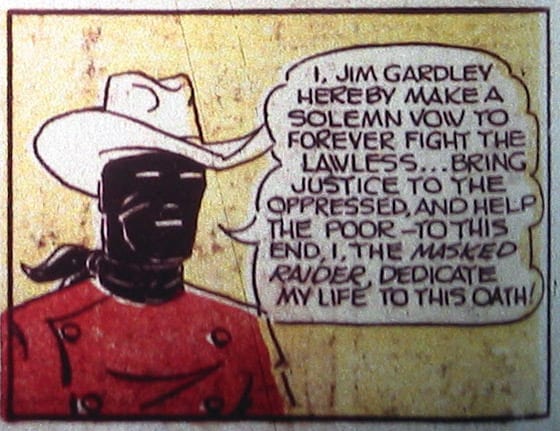
An early version of Rawhide Kid and The Two Gun Kid, The Masked Raider shows readers that the Old West needs Golden Age Marvel heroes too.
Rockman

The original US Agent, that’s Underground Secret Agent, Rockman rocks. I just wish he’d been able to take care of Mole Man.
Golden Girl
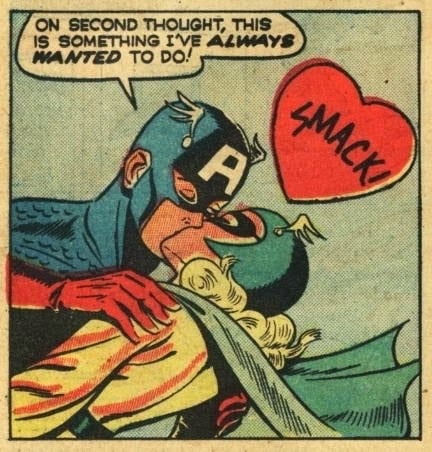
Captain America’s girlfriend and sidekick Betsy Ross was fighting crime before she ever put on an outlandish costume.
The Blonde Phantom

A super-heroine in a ballgown. Although not the most practical of outfits, it sure gave The Blonde Phantom staying power among her fellow Golden Age Marvel heroes with nearly 30 appearances.
The Terror
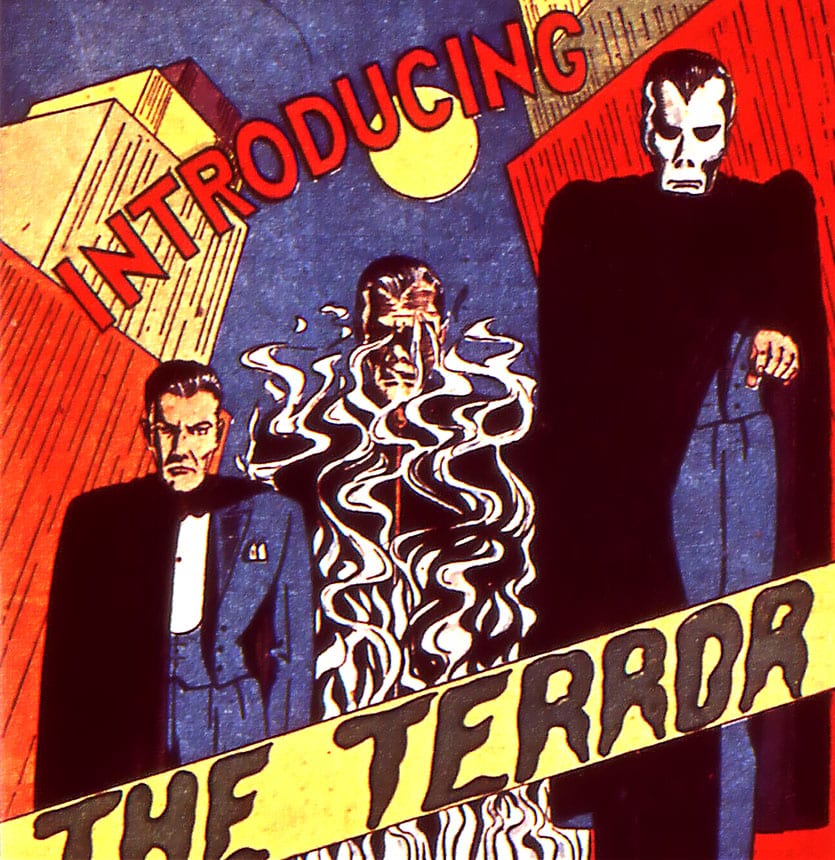
DNA from an enraged dog and a tip of the hat to Bela Lugosi is all this hero needed to fight crime. And, kudos to The Terror for having the lamest alter-ego, Laslo Pevely. Now, without further ado, I present …
Golden Age Marvel Heroes: B-Listers and Sidekicks #10 – The Blazing Skull (B-Lister)

Making his first appearance in Mystic Comics #5 (cover date March 1941), The Blazing Skull gets representation on this list of Golden Age Marvel heroes chiefly because of the Silver Age character of whom he appears to be the prototype, and because he made Hitler cry.
With a name like “The Blazing Skull” and the mask to match it, True Believers have probably already guessed that he’s a prototypical Ghost Rider. Unlike Ghost Rider, though, The Blazing Skull isn’t possessed by a demon, nor does he ride a sweet motorcycle. More similar to his short-lived Golden Age counterpart The Red Raven, The Blazing Skull learned his powers from a secret society of weirdos.
Unlike other first appearances of Golden Age Marvel heroes, The Blazing Skull’s gives only a hint to his origin. Readers learn that The Blazing Skull’s real name is Mark Todd, and that Todd learned his fantastic powers by hanging out with the “Skull Men” of “the Orient”. As an homage to these Skull Men, Todd wears a burning skull mask. His (fluctuating) powers appear to include super-strength, increased agility, and a resistance to fire (made obvious by the fact that his head doesn’t catch fire when he puts his burning mask on).
The Blazing Skull’s first appearance concerns the secret mission we see him undertake. Stopping a torpedo in the water and jumping on a moving train on his way, Todd travels from “the Orient” to Berlin, behind enemy lines. Once there he meets a man named Powell. Powell sends Todd on a mission to destroy a Nazi nerve-gas plant and kill the scientist responsible for manufacturing the gas. But, after killing the Nazi scientist by blowing up the plant with a grenade, Todd is captured and brought to Nazi headquarters.
Todd’s captors torture him until “Der Leader” (Hitler, unnamed) arrives to question him personally. During their talk, The Blazing Skull yells at Hitler, causing him to burst into tears and rush out of the room! After this emotional display, The Blazing Skull is able to escape thanks to an inept guard. Mark Todd’s second adventure in Mystic Comics #6 (cover date October 1941) shows him saving the life of Prime Minister Winston Churchill. Cheers, Skull Men!
Golden Age Marvel Heroes: B-Listers and Sidekicks #9 – Thin Man (B-Lister)

Another character who’s notable mostly because of his Silver Age counterpart is Klaus Nordling‘s Thin Man. First appearing in Mystic Comics #4 (cover date August 1940), Thin Man’s real name is Bruce Dickson. Dickson, a scientist, is on an American expedition to Mt. Kalpurthia, a (fictional) part of the Himalayas. During the expedition Dickson gets lost in a blizzard and winds up in Kalahia, a lost civilization nestled in a valley near the mountain. The Kalahians operate on an unconscious Dickson with “electronic rays”. When he wakes up, Bruce realizes he has the ability to flatten his body.
If you haven’t figured out yet, Thin Man is a prototype for the Silver Age character Mr. Fantastic. And, for any DC fans reading this article, please note that Thin Man first appeared on the scene a full year before Plastic Man first appeared in Police Comics #1 in August 1941.
After some discussion with the Kalahian elders, Dickson eventually convinces them that he must leave their utopia and fight evil in the outside world. He takes Olalla, the only daughter of the chief Kalahian elder, with him, and the two bust up a taxicab protectionism racket back in the States. This would prove to be Thin Man’s only Golden Age adventure, but he returned in the ’70s, along with several other Golden Age heroes, in Roy Thomas’s WWII-themed Marvel Premiere #29 (cover date April 1976), part of his ret-con run on Invaders, but that’s another story.
Golden Age film buffs may notice some striking similarities between Thin Man’s Kalahian origins and the 1937 Frank Capra epic Lost Horizon. In Lost Horizon, diplomat Robert Conway’s (Ronald Colman) plane crashes in the Himalayas. He and his men are rescued and taken to Shangri-La, a temperate utopia nestled in the high-altitude mountain range.
Golden Age Marvel Heroes: B-Listers and Sidekicks #8 – Hurricane (B-Lister)

Hurricane’s first appearance is up for debate. Ret-cons have since amalgamated Hurricane with Mercury, a very similar Golden Age hero, and given him the name “Makkari“. Mercury’s first appearance was in the hard-to-find Red Raven Comics #1 (cover date August 1940) whereas the character named “Hurricane” first appeared in Captain America Comics #1 (cover date March 1941). As with numbers 9 and 10, Hurricane earned a spot on this list of Golden Age Marvel heroes because he was likely an inspiration for a Silver Age one.
With Hurricane’s otherworldly origin, he’s an Olympian god, one might think that the Silver Age hero I’m referring to is Hercules or Thor, especially because Hurricane’s referred to as Thor’s son in Captain America Comics #1. But, Hurricane’s powers set him apart from Hercules or Thor. One of the original speedsters (The Flash debuted in Flash Comics #1 in January 1940 just eight months before Red Raven Comics #1), Hurricane is more of a prototype of Quicksilver than he is of Thor, even down to his sometimes flippant personality.
Hurricane’s cousin Pluto, under the assumed name of Paul Sayden, is the boss of a murder gang. Hurricane tracks Pluto to a costume ball and the two face off, Pluto dressed as Satan and Hurricane wearing his usual crime-fighting garb (i.e. winged headband and boots, briefs, and gloves). In the reality-altering conclusion to their duel, Hurricane bests Pluto and sends him back to wherever he came from (presumably Hades). Hurricane eventually takes the name “Michael Gray” and continues his fight against injustice in subsequent Timely comics.
Golden Age Marvel Heroes: B-Listers and Sidekicks #7 – Rathia (Sidekick – The Sub-Mariner)
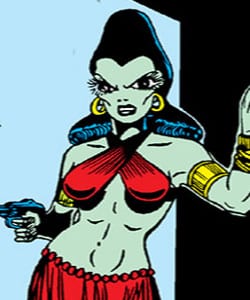
Rathia made her debut in Human Torch Comics #5b (a Golden Age version of renumbering gave Human Torch Comics two #5 issues in order to address the fact that there was no Human Torch Comics #1: Human Torch Comics replaced Red Raven Comics, of which there was only one issue). And, although Rathia is essentially a villain in the epic 60-page story that features her debut, so is The Sub-Mariner who becomes a modern-day Napoleon, trying to take over the world. Rathia spurs the undersea prince on, encouraging him to become the ruthless dictator she desires.
Rathia hails from the Baltic Sea and demands restitution for her injured and dead undersea countrymen, wounded and killed by debris from naval battles above. And, after enticing Namor to attack the warring land dwellers, Rathia also convinces him that his shaky relationship with The Human Torch is not in Namor’s best interests. So, even though The Sub-Mariner and The Human Torch had previously settled their differences, Rathia is able to stir up old hostilities while also providing readers with the impetus for the first-ever multi-title crossover in Marvel’s golden age (more on that next week!).
Golden Age Marvel Heroes: B-Listers and Sidekicks #6 – Jack Frost (B-Lister)
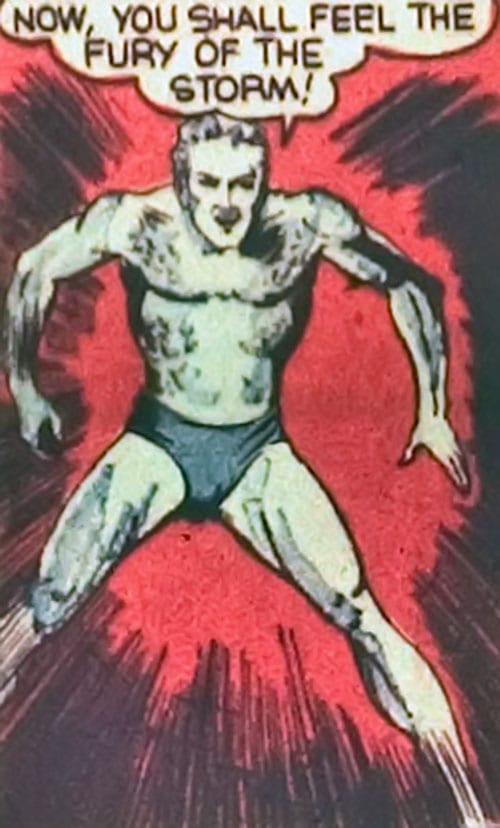
Jack Frost is another Golden-Ager who made this list because of his similarity to a Silver Age hero. Although Jack Frost has otherworldly origins (he’s Jack Frost), from a powers perspective he seems like a prototype of the Silver Age Iceman, Bobby Drake. Like the original drawings of Iceman, Jack Frost appears as a well-sculpted snowman who wears a minimal amount of clothing (boots in Iceman’s case, briefs in Jack Frost’s).
Jack Frost first appeared in U.S.A. Comics #1 (cover date August 1941). Also similar to Iceman who debuted in X-Men #1 (cover date September 1963), as the first page of Jack Frost’s debut shows, it’s written by Stan Lee! This story is one of Stan the Teenage Man’s first for Timely Comics. It shows Jack Frost awoken by a dying arctic explorer who seeks justice! The explorer’s name is Forbes. He is dying of a gunshot wound, courtesy of one Mike Zelby. Forbes begs Jack Frost to protect his daughter Alice. He fears Zelby will target her next.
Jack Frost does Forbes one better. Frost saves Alice’s life and allows Zelby to burn to death in a fire Zelby himself starts. Alice pleads with Jack Frost to save Zelby from the fire, but the literally coldhearted hero refuses, saying Zelby must pay for his crimes. The police come to arrest Jack Frost for Zelby’s murder, but the Golden Age Iceman vanishes. He swears that if he can’t work with the police then he’ll work against them. You know, I think there’s a Sonny Curtis song about that.
Golden Age Marvel Heroes: B-Listers and Sidekicks #5 – The Patriot (B-Lister)

The Patriot made this list of because of his staying power and because of his ret-conned title as the longest serving Golden Age Captain America. The Patriot is Jeff Mace, a reporter with a desire to do good. His first published exploit from Human Torch Comics #4 (cover date Spring 1941), a text-only story, has him averting a fifth column plot to kill a number of government officials in a plane crash on their way to ease tensions at a striking munitions plant. This story, described in the text as occurring “about a year ago,” is told from Mace’s perspective as if he’s recounting his first adventure as The Patriot to the reader. But, if his first exploit as The Patriot occurred in the spring of 1940 then his character biography as a crime-fighter goes back further than Captain America’s, who only appeared on the scene in 1941.
The Patriot’s first four-colour feature story also debuted in Human Torch Comics #4 as that issue’s final story. It shows Jeff take on a group of (surprise!) fifth columnists who call themselves “The Yellowshirts”. The Yellowshirts seek to rob America of its civil liberties. The Yellowshirts take control of a news outlet in order to distribute their propaganda. The Patriot fights his way to the big man, and after subduing the boss of The Yellowshirts The Patriot is the hero of the hour.
In terms of his ret-conned title as the as the longest-serving Golden Age Captain America, most Marvelites will remember that the 1964 ret-con in Avengers #4 revealed that Steve Rogers and the original Bucky disappeared in 1945 shortly before WWII ended. According to a subsequent ret-con (Roy Thomas’s What If? #4, cover date August 1977), shortly thereafter at the behest of President Truman a new Captain America and Bucky took over for the MIA star-spangled duo.
The role of Bucky was taken on by Fred Davis Jr., a New York Yankees bat-boy who had already masqueraded as Bucky in Roy Thomas’s ret-con Marvel Premiere #30 (cover date June 1976). The role of Captain America was taken on by William Nasland, AKA The Spirit of ’76 who first appeared in another Roy Thomas ret-con Invaders #14 (cover date March 1977). Nasland is killed in action in 1946 as part ofWhat If? #4, and Jeff Mace replaces him as Cap.
Subsequent ret-cons have Jeff Mace serving as Captain America until 1952 when he hangs up the red, white, and blue outfit. So, Jeff Mace has six years as the Golden Age Captain America compared to Steve Rogers’s four and William Nasland’s one. Ain’t ret-cons grand (and confusing)?
Golden Age Marvel Heroes: B-Listers and Sidekicks #4 – The Destroyer (B-Lister)

Like his contemporary Jack Frost, a teenage Stan lee created the Destroyer. I include the him on this list because of his unique garb and courage. The Destroyer made his first appearance in Mystic Comics #6.
The Destroyer is Keen Marlow, although later ret-cons changed his name to Kevin. Similar to Jeff Mace, Keen Marlow is an American reporter. But, unlike Mace who generally deals with domestic rather than foreign disputes, Marlow works behind enemy lines. His editor demands the real story on what’s happening in Germany.
Marlow truly goes above and beyond in his effort to write a good story for his editor. He breaks into a Nazi prison, gets captured and interrogated by Nazi soldiers, beats the crap out of them, and eventually gets re-captured. Meanwhile in another part of the prison, Professor Schmitt, world-famous biochemist, refuses to give up his super soldier serum. Schmitt is thrown into the same cell as Marlow, and, after explaining what it is, proffers his serum to Marlow.
The professor dies as a result of his mistreatment at the hands of the Nazi guards, but Marlow is invigorated by Schmitt’s formula. After swearing an oath to fight Nazism, Marlow breaks out of the Nazi prison, frees its prisoners, and locks up the Nazi guards. Like many Marvel superheroes, he then goes home to design a gaudy costume.
The next time he goes out, Marlow goes out as The Destroyer. The Destroyer first saves a young woman from being bullied by some storm-troopers. And, after being captured again, he destroys a Nazi lieutenant’s home. The Destroyer’s next adventure, published immediately after his first story in Mystic Comics #6, shows him facing off against his longtime nemesis The Scar.
Golden Age Marvel Heroes: B-Listers and Sidekicks #3 – Miss America (B-Lister)

No, she’s not Captain America’s sister, daughter, cousin, or aunt. Making her debut a little late in Marvel Mystery Comics #49 (cover date November 1943), Miss America is Madeline Joyce. She is the niece and adopted daughter of millionaire James Bennett. Bennett funded the experiment that, unbeknownst to him, gave Madeline her powers. Although she wasn’t the first heroine to grace the pages of Timely Comics, she was likely Timely’s most popular one. Another contender for that title is Golden Girl, Betsy Ross. But, since Golden Girl was a sidekick and Miss America had her own title, I say the two are in different leagues.
When compared to the Timely heroines who had their own titles, Madeline Joyce has staying power. Female crime-fighters contemporary with Miss America didn’t stick around too long after their debuts. The original Black Widow only got five golden-age stories, The Silver Scorpion appears to have only gotten three, and Zara of the Jungle only got two. Miss America, on the other hand, appears to have made more than thirty Golden Age appearances in her own stories! The Blonde Phantom is the only Timely heroine who comes close, just shy of thirty golden-age appearances.
In her time, Miss America was a Nazi fighter par excellence. In fact, her final story in Marvel Mystery Comics #85 (cover date February 1948) shows her fighting Nazis and collaborators long after the hostilities of WWII had ended. So, for standing up to fifth columnists, Axis forces, and a skeptical buying public who didn’t seem to care about super-heroines, Miss America has more than earned her place on this list.
Golden Age Marvel Heroes: B-Listers and Sidekicks #2 – Toro (Sidekick – The Original Human Torch)

Making his first appearance in Human Torch Comics #2 (cover date Fall 1940), Toro debuted six months before Bucky. Toro, Thomas Raymond, made this list because of the lasting impression he made on what would become Marvel Comics.
It’s true that in many ways Toro is a knockoff character. His powers are a rehash of the Human Torch’s. His introduction as a boy sidekick is an obvious knockoff of the introduction of the original Robin, Dick Grayson. Robin made his first appearance just a few months previous to Toro’s, in April 1940.
Toro, like many of the names on this list, seems to be a prototype for a Silver Age hero. I’m talking about the other Human Torch, Johnny Storm. I can hear you already. “Wouldn’t the Silver Age Human Torch have more in common with the Golden Age Human Torch than Toro?” The answer, not really. The original Human Torch is a man (or android) of action like Johnny. But, unlike his Silver Age counterpart, he’s basically a loner who desires justice. Toro, like Storm, is a kid who has a lot of fun while turning the heat up on crime.
Toro also makes this list because he’s a selfless kid who routinely risks everything to save the day. I won’t say much about his Silver, Bronze, and Modern Age exploits. Let’s just say that they involve a lot of self-sacrifice. Instead, let’s talk about his first appearance.
The Human Torch AKA Jim Hammond, while flying over a circus one day, sees a boy on fire. Hammond touches down to see if he can help. And, he finds the boy, Toro, unharmed by his own fiery performance. The Human Torch realizes that his proximity to Toro must somehow have set off his latent abilities. They realize that Toro can mentally control his flame, and the Torch offers to train him.
Toro tells the Torch he’s always been fireproof, even when attempting to rescue his dying parents from a train derailment. And, though he came from tragedy, The Human Torch assures Toro his future is bright.
Toro quickly becomes the star attraction of “Pop’s Circus”. Unfortunately, Samson the circus strongman doesn’t like this turn of events. Samson gets a hold of an experimental “Rayon Gun” and uses it to nullify The Human Torch’s powers. Samson gets in a few good hits on the Torch. But, once his powers return the Torch and Toro burn off Samson’s mustache, and convince him to give himself up.
Two of Samson’s accomplices seem like they’ll get away. So, Toro and The Human Torch murder them by flying them into the air and then letting them fall! Toro, showing he’s got the sociopathic personality of a true Golden Age hero, says, “Nasty spill! But they deserved it!” By routing out the mobsters, Toro and the Torch save Pop’s Circus. Their next adventure in Human Torch Comics #3 doesn’t go as well. Although they eventually manage to bust up a spy ring, the Torch actually spanks Toro, calling him a “spoiled pup”!
Golden Age Marvel Heroes: B-Listers and Sidekicks #1 – Bucky (Sidekick – Captain America)

Was there a doubt that Captain America’s sidekick Bucky Barnes would take the #1 spot on this list? If you want to read about Bucky’s origin, check this article. Here I’ll talk about why Bucky deserves to be number one.
Although Toro debuted a few months before him, Bucky developed more of a fan-base than his fiery rival. This is best shown by the fact that there have been three MCU movies (Captain America: The First Avenger, Captain America: Winter Soldier, and Captain America: Civil War) that feature Bucky and none that even mention Toro. As sidekicks go, Toro was independent and mouthy. Golden Age Bucky, though, was a true sidekick to Captain America. He even dressed up in a “Little Lord Fauntleroy” outfit at Cap’s order on one occasion. Plus, Toro is basically invulnerable when he has his flame on. Bucky, though, is susceptible to bullets, gas, drowning, and explosions no matter how hot he gets.
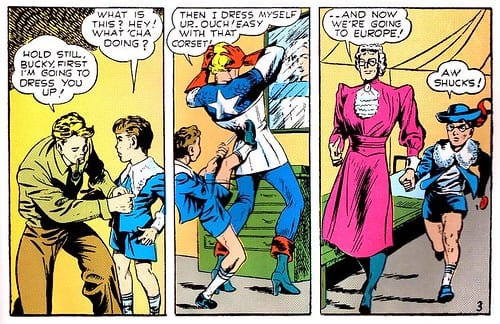
In his first exploit as Cap’s sidekick, Bucky grabs a bomb from an attacker and throws it outside. The ensuing blast sends an unhurt Bucky flying across the room. And, though this may seem like a small act in the world of comics, the bomb if allowed to detonate inside would probably have injured Cap and killed Betsy Ross. So, Bucky gets big points for saving his boss and his boss’s girlfriend his first time out.

